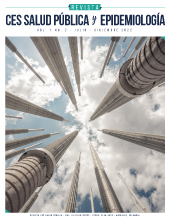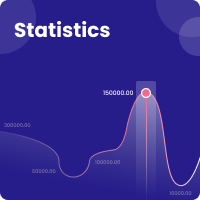Physical Inactivity among Faculty Members in a Health School
DOI:
https://doi.org/10.21615/cesspe.6872Keywords:
teachers, accelerometry, work, lifestyleAbstract
Physical activity is an effective practice to care for the physical and mental health in the general population. However, the population has low levels of physical activity. A particular population is the one of university professors who, due to the needs of the institutions and students, they often invest additional time from their free time, executing work activities, which results in a diversity of low energy expenditure activities. Objective: to estimate the prevalence of physical inactivity in a group of university professors from a health school, and to explore whether work factors are associated with this behavior. Methods: quantitative observational study with a descriptive approach and analytical intent, in which 34 professors from a faculty in the health area who were occupationally linked in the year 2021 participated. The dependent variable was physical inactivity, measured by accelerometry. In addition, sociodemographic, anthropometric, labor and lifestyle characteristics were investigated. The analysis is conducted through descriptive measures, hypothesis test and crude prevalence ratios. Results: it was found that four out of ten teachers are apparently inactive; Although the labor characteristics are not associated, some characteristics suggest a higher proportion of inactive teachers. Conclusion: the performance of physical activity in teachers is not enough to comply with the minimum levels recommended to protect health. Although the factors of the working day do not seem to be associated, perhaps due to the homogeneity of characteristics of this particular group, it is important that, from the institutional welfare systems, strategies and spaces are provided that guide their actions towards the promotion of healthy behaviors that can improve the teacher’s health.
Downloads
References
Organización Mundial de la Salud. Recomendaciones mundiales sobre actividad física para la salud [Internet]. Ginebra: Organización Mundial de la Salud; 2010 [citado 9 de agosto de 2020]. Disponible en: http://whqlibdoc.who.int/publications/2010/9789243599977_spa.pdf
García CM, González JA. Impacto de la inactividad física en la mortalidad y los costos económicos por defunciones cardiovasculares: evidencia desde Argentina. Rev Panam Salud Pública. 21 de julio de 2017;41:1.
Organización Mundial de la Salud. Actividad física [Internet]. [citado 17 de abril de 2022]. Disponible en: https://www.who.int/es/news-room/fact-sheets/detail/physical-activity
Márquez JJ. Inactividad física, ejercicio y pandemia COVID-19. VIREF Rev Educ Física. mayo de 2020;9(2):43-56.
Leiva AM, Martínez MA, Cristi C, Salas C, Ramírez R, Díaz X, et al. El sedentarismo se asocia a un incremento de factores de riesgo cardiovascular y metabólicos independiente de los niveles de actividad física. Rev Médica Chile. abril de 2017;145(4):458-67.
Salvo D, Garcia L, Reis RS, Stankov I, Goel R, Schipperijn J, et al. Physical Activity Promotion and the United Nations Sustainable Development Goals: Building Synergies to Maximize Impact. J Phys Act Health. 2021;1-18.
Ahumada J, Toffoletto M. Factores asociados al sedentarismo e inactividad física en Chile: una revisión sistemática cualitativa. Rev Médica Chile. febrero de 2020;148(2):233-41.
Koohsari MJ, Nakaya T, McCormack GR, Shibata A, Ishii K, Oka K. Changes in Workers’ Sedentary and Physical Activity Behaviors in Response to the COVID-19 Pandemic and Their Relationships With Fatigue: Longitudinal Online Study. JMIR Public Health Surveill. 26 de marzo de 2021;7(3):e26293.
Puma D, Martínez K, Sánchez B, Ortiz R, Zavaleta E, Moreno G. Tesis para optar por el título profesional de Licenciado en tecnología médica en la especialidad de terapia física y rehabilitación. :39.
Kua Z, Hamzah F, Tan PT, Ong LJ, Tan B, Huang Z. Physical activity levels and mental health burden of healthcare workers during COVID‐19 lockdown. Stress Health. febrero de 2022;38(1):171-9.
Mota IA, Oliveira GD de, Morais IP, Dantas TF. Impact of COVID-19 on eating habits, physical activity and sleep in Brazilian healthcare professionals. Arq Neuropsiquiatr. mayo de 2021;79(5):429-36.
Hernández M, Puentes AB, García M. Covid-19. ¿Cómo afecta a la realización de ejercicio físico en médicos? Med Clínica. agosto de 2020;155(4):178.
Ministerio de Educación. Función docente: Ministerio de Educación Nacional de Colombia [Internet]. Función docente: Ministerio de Educación Nacional de Colombia. [citado 26 de abril de 2022]. Disponible en: https://www.mineducacion.gov.co/1621/article-80258.html
Rosales Y, Orozco D, Yaulema L, Parreño Á, Caiza V, Barragán V, et al. Actividad física y salud en docentes. Una revisión. Apunts Med Esport. octubre de 2017;52(196):159-66.
Stubbs B, Koyanagi A, Hallgren M, Firth J, Richards J, Schuch F, et al. Physical activity and anxiety: A perspective from the World Health Survey. J Affect Disord. enero de 2017;208:545-52.
Congreso de Colombia. Ley 528 de 1999 - Gestor Normativo - Función Pública [Internet]. [citado 26 de abril de 2022]. Disponible en: https://www.funcionpublica.gov.co/eva/gestornormativo/norma.php?i=66199
Bedoya L, Hernández ME, Bedoya D, Ríos X, Silva C, Guerrero B, et al. Guía Estilos de Vida Saludable. Medellín (Antioquia, Colombia): Alcaldía de Medellín; 2018.
Arenas MM, Patiño FA, Quintero MA. Manual antioqueño de actividad física para la salud. Medellín (Antioquia, Colombia): Gobernación de antioquia; 2011.
Organización Mundial de la Salud. Directrices de la OMS sobre actividad física y hábitos sedentarios: de un vistazo [Internet]. Ginebra: Organización Mundial de la Salud; 2020 [citado 28 de abril de 2022]. Disponible en: https://apps.who.int/iris/handle/10665/337004
Miluska J. Objetivos y metas de desarrollo sostenible [Internet]. Desarrollo Sostenible. [citado 28 de abril de 2022]. Disponible en: https://www.un.org/sustainabledevelopment/es/sustainable-development-goals/
Kunene SH, Taukobong NP. Level of physical activity of health professionals in a district hospital in KwaZulu-Natal, South Africa. South Afr J Physiother. 28 de abril de 2015;71(1):6 pages.
Iwuala S, Sekoni A, Olamoyegun M, Akanbi M, Sabir A, Ayankogbe O. Self-reported physical activity among health care professionals in South-West Nigeria. Niger J Clin Pract. 2015;18(6):790.
Moreno R, Fernández AB, Linares M, Espejo T. Revisión sistemática sobre hábitos de actividad física en estudiantes universitarios. Sport Sci J Sch Sport Phys Educ Psychomot. 1 de enero de 2018;4(1):162-83.
Colegio Médico Colombiano. Los médicos, ejemplo para los pacientes [Internet]. Colegio Médico Colombiano. 2019 [citado 26 de abril de 2022]. Disponible en: https://epicrisis.org/2019/07/18/los-medicos-ejemplo-para-los-pacientes/
Franco AL, Flórez JA. Correlación entre el nivel de actividad física y el perfil antropométrico de trabajadores de la empresa Sertures de Colombia S.A.S. Rev Digit Act Física Deporte. 1 de enero de 2020;6(1):5-13.
Retuerto MA, Millones E, Zafra JH. Factores sociodemográficos asociados a actividad física y sedentarismo en población peruana adulta. Rev Peru Epidemiol. 2013;17(3):1-6.
Migueles JH, Cadenas C, Ekelund U, Delisle C, Mora J, Löf M, et al. Accelerometer Data Collection and Processing Criteria to Assess Physical Activity and Other Outcomes: A Systematic Review and Practical Considerations. Sports Med. septiembre de 2017;47(9):1821-45.
World Health Organization, Council for International Organizations of Medical Sciences. International ethical guidelines for health-related research involving humans. Geneva: CIOMS; 2017.
The World Medical Association-Declaración de Helsinki de la AMM. Principios éticos para las investigaciones médicas en seres humanos [Internet]. [citado 17 de abril de 2022]. Disponible en: https://www.wma.net/es/policies-post/declaracion-de-helsinki-de-la-amm-principios-eticos-para-las-investigaciones-medicas-en-seres-humanos/
Ministerio de Salud y Protección Social. Resolución número 8430 de 1993: Por la cual se establecen las normas científicas, técnicas y administrativas para la investigación en salud. Colombia: Ministerio de Salud, República de Colombia; 1993.
Thivel D, Tremblay A, Genin PM, Panahi S, Rivière D, Duclos M. Physical Activity, Inactivity, and Sedentary Behaviors: Definitions and Implications in Occupational Health. Front Public Health. 5 de octubre de 2018;6:288.
Angrave D, Charlwood A, Wooden M. Long working hours and physical activity. J Epidemiol Community Health. agosto de 2015;69(8):738-44.
Suárez GR, Zapata S, Cardona J. Estrés laboral y actividad física en empleados. Diversitas. 1 de enero de 2014;10(1):131.
Abu M, Hatamelh M. Working Experience and Perceived Physical Activity and Exercise Barriers. Sport Mont [Internet]. 1 de junio de 2019 [citado 21 de abril de 2022];17(2). Disponible en: http://www.sportmont.ucg.ac.me/?sekcija=article&artid=1465
Flores A, Pino YM, Villamar MÓ. Actividad física y su relación con el sobrepeso y obesidad en docentes de la Universidad Nacional del Altiplano Puno 2017. Sport Sci J Sch Sport Phys Educ Psychomot. 11 de diciembre de 2019;6(1):61-79.
Dias DF, Loch MR, González AD, Andrade SM de, Mesas AE. Insufficient free-time physical activity and occupational factors in Brazilian public school teachers. Rev Saúde Pública [Internet]. 20 de julio de 2017 [citado 18 de abril de 2022];51(0). Disponible en: http://www.scielo.br/scielo.php?script=sci_arttext&pid=S0034-89102017000100256&lng=en&tlng=en
Abelson P, Kennedy D. The Obesity Epidemic. Science. 4 de junio de 2004;304(5676):1413-1413.
Valencia A. Actividad física y uso sedentario de medios tecnológicos de pantalla en adolescentes. 2013 [citado 21 de abril de 2022]; Disponible en: https://roderic.uv.es/handle/10550/28151
Alvarez GM, Guadalupe M, Morales H, Guadalupe M, Morales H, Robles J, et al. El sedentarismo y la actividad física en trabajadores administrativos del sector público / Sedentary lifestyle and physical activity in administrative public sector workers. Cienc UNEMI. 10 de mayo de 2017;9(21):116-24.
Erick PN, Smith DR. A systematic review of musculoskeletal disorders among school teachers. BMC Musculoskelet Disord. diciembre de 2011;12(1):260.
Yue P, Liu F, Li L. Neck/shoulder pain and low back pain among school teachers in China, prevalence and risk factors. BMC Public Health. diciembre de 2012;12(1):789.
Blázquez A, León A, Feu S. Intención y práctica de actividad física en maestros españoles. Cuad Psicol Deporte. mayo de 2015;15(2):163-70.
Sallis JF, Cerin E, Conway TL, Adams MA, Frank LD, Pratt M, et al. Physical activity in relation to urban environments in 14 cities worldwide: a cross-sectional study. The Lancet. mayo de 2016;387(10034):2207-17.
Heath GW, Brownson RC, Kruger J, Miles R, Powell KE, Ramsey LT. The Effectiveness of Urban Design and Land Use and Transport Policies and Practices to Increase Physical Activity: A Systematic Review. J Phys Act Health. febrero de 2006;3(s1):S55-76.
Comunicación P. ¿Sabes qué es efr? [Internet]. Universidad CES. 2019 [citado 27 de abril de 2022]. Disponible en: https://www.ces.edu.co/noticias/sabes-que-es-efr/
Gonzales S, Sarmiento O, Lozano O, Ramirez A, Grijalba C. Niveles de actividad física de la población Colombiana: desigualdades por sexo y condición socioeconómica. Biomédica. Mayo de 2014; 34(3).
Rezende LF, Rey JP, Matsudo V, Luiz O. Sedentary behavior and health outcomes among older adults: a systematic review. BMC Public Health. diciembre de 2014;14(1):333.
Schwendinger F, Pocecco E. Counteracting Physical Inactivity during the COVID-19 Pandemic: Evidence-Based Recommendations for Home-Based Exercise. Int J Environ Res Public Health. 1 de junio de 2020;17(11), E3909.
Bull FC, Al SS, Biddle S, Borodulin K, Buman MP, Cardon G, et al. World Health Organization 2020 guidelines on physical activity and sedentary behaviour. Br J Sports Med. diciembre de 2020;54(24):1451-62.
Bienestar Universitario CES. Actividad física y nuevas modalidades [Internet]. Universidad CES. [citado 27 de abril de 2022]. Disponible en: https://www.ces.edu.co/bienestar-institucional-y-desarrollo-humano/actividad-fisica-y-nuevas-modalidades-2/
Downloads
Published
How to Cite
Issue
Section
License
Copyright (c) 2023 Revista CES Salud Pública y Epidemiología

This work is licensed under a Creative Commons Attribution-NonCommercial-ShareAlike 4.0 International License.
Derechos de reproducción (copyright)
Cada manuscrito se acompañará de una declaración en la que se especifique que los materiales son inéditos, que no han sido publicados anteriormente en formato impreso o electrónico y que no se presentarán a ningún otro medio antes de conocer la decisión de la revista. En todo caso, cualquier publicación anterior, sea en forma impresa o electrónica, deberá darse a conocer a la redacción por escrito.
Plagios, duplicaciones totales o parciales, traduccones del original a otro idioma son de responsabilidad exclusiva de los autores el envío.
Los autores adjuntarán una declaración firmada indicando que, si el manuscrito se acepta para su publicación, los derechos de reproducción son propiedad exclusiva de la Revista CES Salud Pública y Epidemiología.
Se solicita a los autores que proporcionen la información completa acerca de cualquier beca o subvención recibida de una entidad comercial u otro grupo con intereses privados, u otro organismo, para costear parcial o totalmente el trabajo en que se basa el artículo.
Los autores tienen la responsabilidad de obtener los permisos necesarios para reproducir cualquier material protegido por derechos de reproducción. El manuscrito se acompañará de la carta original que otorgue ese permiso y en ella debe especificarse con exactitud el número del cuadro o figura o el texto exacto que se citará y cómo se usará, así como la referencia bibliográfica completa.
| Article metrics | |
|---|---|
| Abstract views | |
| Galley vies | |
| PDF Views | |
| HTML views | |
| Other views | |



